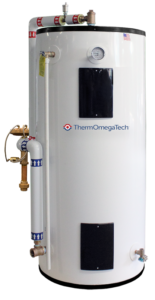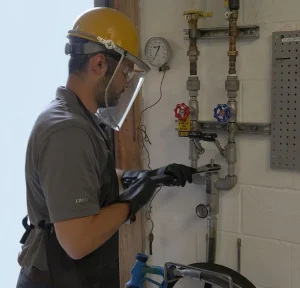Emergency showers, facewash stations, and eyewash stations are essential for prompt decontamination in workplaces prone to chemical spills or exposure to hazardous materials.
These stations, strategically located in areas like power plants, industrial facilities, and labs, allow individuals to rinse off harmful substances in case of emergencies.
The Importance of Tepid Water in Emergencies

Tepid showers are critical in protecting personnel and complying with regulatory requirements. If a person’s body and eyes are exposed to a corrosive and dangerous substance at work, they need instant access to a water supply to saturate their bodies and flush their eyes.
A consistent flow of tepid water from emergency showers and eyewash stations prevents thermal shock or burns and ensures effective flushing without discomfort.
Many facilities have emergency fixtures, including laboratories, chemical, petrochemical, pharmaceutical, manufacturing plants, agriculture and mining facilities, oil refineries, and educational facilities.
Let’s explore the importance of using tepid water in emergency showers and how it affects workplace safety.
What is Tepid Water?
Tepid degree water is defined as having a temperature between 60-100ºF (15.6-37.8ºC). This temperature range is considered suitable for providing comfort and preventing further injury when using an emergency shower, facewash, or eyewash station after bodily exposure to hazardous materials.
The ANSI Z358.1-2014 standard is a guideline for selecting, installing, operating, and maintaining safety showers, facewash stations, and eyewash stations.
The standard states where emergency fixtures need to be located, the required spray patterns, minimum flow rates, water temperature requirements, and the time the water needs to be supplied.
Why Do Emergency Showers Need Tepid Water?
Having tepid water readily available from emergency showers is essential to operator safety. Temperatures too high could burn the employee or open their pores, allowing dangerous substances to sink into their skin. Too cold water can lead to hypothermia or shock. Here’s why tepid showers are crucial:
Effective Decontamination: Tepid water is optimal for flushing chemicals or contaminants from the eyes, face, and body in case of chemical spills, splashes, or exposure. It helps dilute and remove hazardous substances more effectively than water that is too hot or too cold, aiding in rapidly removing contaminants to minimize potential injuries.
Compliance with Regulations: Many safety regulations and standards, such as ANSI/ISEA Z358.1, require tepid water in emergency eyewash and safety shower systems. Compliance with these regulations ensures facilities provide appropriate emergency response measures to protect workers’ health and safety.
Extended Flushing Duration: Tepid water encourages longer flushing durations, as individuals are more likely to endure the discomfort of flushing contaminants from their eyes or skin with water that is neither too hot nor too cold. Longer flushing times enhance the effectiveness of decontamination and reduce the risk of injury. The tepid water temperature ensures the injured person can endure the recommended 15 minutes of continuous flushing.
Prevention of Further Injury: In cases of chemical exposure, using tepid water for decontamination helps to prevent thermal shock, which can exacerbate injuries and increase tissue damage. Tepid water promotes gentle yet thorough flushing to minimize the risk of further injury to affected individuals.
Types of Tepid Water Systems
Various tepid water systems for safety showers, facewash, and eyewash stations are available. These include mixing valves for hot and cold-water supply lines, turnkey systems with pre-packaged, self-contained heating and mixing valves, instantaneous electric heaters, and steam-fired heaters.
ThermOmegaTech’s Therm-O-Mix® steam-fired tepid water delivery system uses existing plant steam and water to supply face/eyewash stations and safety showers with tepid water.
The unit functions 100% mechanically, needing no external power source, making it ideal for explosive-proof environments. It’s self-purging, so no elaborate drainage or expensive recirculation systems are required.
If your facility does not have a steam supply, ThermOmegaTech also offers the heavy-duty ESS Emergency Safety Shower Water Heater, bundled with the Therm-O-Mix Station/Water-Water Mixing Valve (WWM).
This heavy-duty electric water heater is designed to provide a safe and reliable tepid water supply. It is constructed of a carbon steel tank and internally lined with 1/2″ thick Hydrastone cement to ensure tank longevity when operating at elevated temperatures.
The tank is also fully insulated with 3″ thick polyurethane foam. Unlike instantaneous heaters, the ESS is unaffected by the loss of electric power in its ability to provide tepid water thanks to the thermostatic Therm-O-Mix mixing valve.
Implementing a system that automatically delivers tepid water ensures employees are safely drenched, eliminating risks of scalding or hypothermia during emergencies. This enhancement bolsters safety and provides immediate relief, fostering a secure working environment.
ThermOmegaTech Has Your Solution for Reliable Tepid Water Delivery
ThermOmegaTech® is a leading provider of temperature control solutions designed to meet stringent safety standards for emergency showers and eyewash stations. Our thermostatic tepid water delivery systems ensure your facility is prepared for emergencies while prioritizing the safety and well-being of personnel in industrial and commercial settings.
ThermOmegaTech’s tepid water delivery systems offer peace of mind, enabling organizations to proactively mitigate hazards and protect their most valuable asset—their people.
Contact ThermOmegaTech today to discuss your facility’s tepid water needs.

